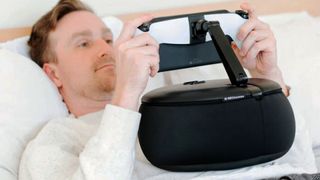The Mechanism Gaming Pillow acts like a third arm for your gaming handhelds and I'm not ashamed to say I kinda want one
In lieu of future cybernetics developments this is about as good as you're going to get.

I love my Steam Deck. Lying down on the sofa or sitting up in bed with the device might not be doing wonders for my partners' perception of me, but as portable PC gaming experiences go, it's pretty great. This bizarre-looking device for holding one aloft, however, initially caught my interest purely out of amusement—but the more I think about it, the more I reckon it's quite a good idea.
The Mechanism Gaming Pillow is available for $59, and acts as a third hand for your handheld gaming devices (via The Verge). The 12-inch pillow is essentially a miniature bean bag chair filled with squishy foam granules, and is designed to sit on uneven surfaces, like your lap or your stomach when you're lying down.
The included Ball Socket Mount in combination with a custom grip (one included) allows you to hold aloft a Steam Deck OG or OLED, Nintendo Switch, ROG Ally or PS Portal at a comfortable height, thanks to an extendable arm. The listing states that the company's goal is for you to "fall asleep before your arms do", and there's even a hilarious animated .gif of a model repeatedly punching himself in the face with the cushion to prove how soft it is.
We've all got to earn a living. Anyway, there's also an optional adhesive mount to attach your phone to the base, or potentially even a battery bank to extend the life of your chosen arm-mounted device. That's a clever little addition, and while it's not the first handheld gaming cushion I've seen, this one looks like some thought went into the materials and the design. And you'll still look less dorky than someone wearing augmented reality glasses to achieve the same effect.
Is this a real problem though? I can tell you from personal experience, yes. I find myself either holding the Steam Deck up at eye-height—in which case my arms eventually become tired—or holding it in my lap and craning over the top of it, which is a pretty awful position for your spine to be in over an extended period of time.
While I still thinks it looks silly, the benefits here might outweigh the potential pitfalls—namely that your living partners are going to make fun of you, and the inevitability of knocking it over, no matter how stable it is. Still, if you're not a complete klutz like me, I reckon it's got the makings of a device that'll make handhelds much more practical to use for long periods at home.
Of course, it is sort of going against the point of portability, but then handheld gaming PCs like the Deck are multifunctional items. For a quick trip on the train or on the tray table during a flight, you're fine with the form factor as is. For knocking around the house though, I reckon this might just save you from the terrors of an aching back.
The biggest gaming news, reviews and hardware deals
Keep up to date with the most important stories and the best deals, as picked by the PC Gamer team.
Best handheld gaming PC: What's the best travel buddy?
Steam Deck OLED review: Our verdict on Valve's handheld.
Best Steam Deck accessories: Get decked out.

Andy built his first gaming PC at the tender age of 12, when IDE cables were a thing and high resolution wasn't. After spending over 15 years in the production industry overseeing a variety of live and recorded projects, he started writing his own PC hardware blog in the hope that people might send him things. And they did! Now working as a hardware writer for PC Gamer, Andy's been jumping around the world attending product launches and trade shows, all the while reviewing every bit of PC hardware he can get his hands on. You name it, if it's interesting hardware he'll write words about it, with opinions and everything.
Most Popular








